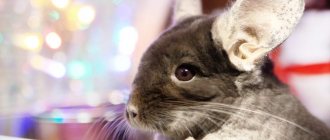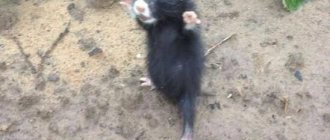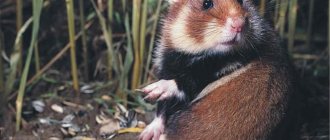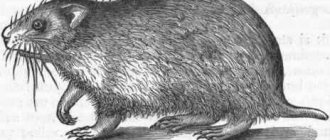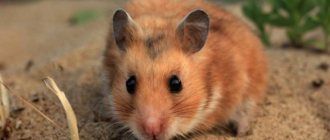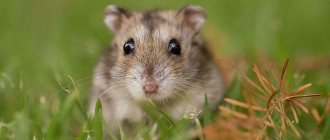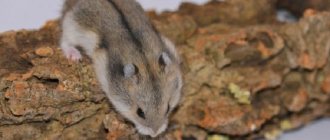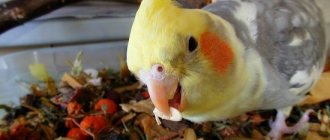And it looks like a funny animal... The carbysh differs from the domestic hamster in its size and character. Moreover, his character is not for the better. Wild hamsters are very aggressive. Watching the video, the thought arises that they completely lack a sense of fear and the instinct of self-preservation. Take a look for yourself:
In addition to the “standard” coloring, which you see in the photo in the title of the article, they can be completely black. In any case, it is a malicious crop pest. The field hamster stores up to 20 kg of vegetables and fruits for the winter, robbing fields and vegetable gardens. But we will talk about the problems that wild hamsters cause to owners of fields and gardens a little later. And now, as one smart person said, “You need to know the enemy by sight.”
He reminds me of someone. Some kind of Kung Fu Panda.
What does a wild hamster look like?
A wild hamster is not a small animal. The male carbysh grows up to 40 cm in length, in females this parameter reaches up to 25–30 cm. The tail is thick, tapered at the end, from 3 to 8 cm long. Weight is about 700 g.
Vasily returned from hunting with decent booty. Today he has a wild field hamster for dinner. A visual photo showing the size of the carbysh.
Compare with a domestic hamster, which will grow a maximum of 10-15 cm. Wild carbysh is more similar in size to a guinea pig.
Karbysh is a frequent visitor to summer cottages and vegetable gardens, so you need to know what a wild hamster looks like so as not to give up when meeting one. The animal's neck is not visible. His head with large cheeks and lush fur flows smoothly into the body. The legs are short but muscular. The claws are hard and very sharp; this is its main tool for breaking through passages and holes. Sharp teeth grow constantly, like the rest of the hamster family. That's why they constantly chew on something and wear down their teeth. The mustache is hard. The eyes are black.
The coat color is varied. Most often, rodents of yellow-brown and brown color appear in dachas and vegetable gardens. The field resident can be completely black or spotted: the abdomen is painted black, with dark spots on the sides. There may be spots of light shades on both sides of the head, on the shoulder blades and on the fur behind the ears.
When moving, the rodent is somewhat clumsy, but only until it senses danger. It can jump on its hind legs, jumping up to 30 cm forward at a time. In squeaks of food it can migrate over distances of up to 50 km.
Appearance
First of all, it is worth noting that this animal belongs to hamsters, being a representative of a rather harmful family. As you can see in the photo, the carbysh animal really looks like other rodents of this species.
- Its color is quite bright, even beautiful.
- The back is yellowish-brown, the belly is black, and the sides are decorated with large white spots. At the same time, the coat is short, but thick and pleasant to the touch, very soft.
- The ears are quite massive and stand out sharply on a neat head.
- The paws are quite wide with thin, sharp claws, which allows the carbysh to dig deep holes in which it will live, store supplies for the winter and raise offspring.
The karbysh is one of the largest hamsters - its weight can reach 750 grams! At the same time, the body is quite dense, compact, up to 35 centimeters long.
The main enemy of the forest hamster
Oddly enough, the main enemies of the karbysh are not forest animals and birds that hunt sinkers (owls, for example), but humans. It is he who causes the greatest damage to the population, exterminating the forest hamster in order to protect his crop from destruction. In the USSR, even the propaganda poster was appropriate:
In a moment of danger, a wild hamster boldly attacks an enemy, even if it is significantly larger in size, including a person. You may have just watched one video, but here's another one for you:
I apologize in advance for the profanity in the video...
Before attacking, the animal tries to intimidate the enemy: it makes sharp, loud sounds, and chatters its teeth.
Method of dealing with carbysh
My colleague suggested a method of fighting. He lives in a private house on the outskirts of Kazan and had exactly the same problems with karbysh as I did. Currently, the animal has disappeared, and according to him, this happened for two reasons. 1. There are a lot of dogs in the village. And dogs are the enemies of karbysh.
2. The entire village began to catch these animals in an organized manner using rat traps.
The trap sizes are arbitrary. In the version of the trap in the photo, dimensions are 35x15x15 cm. The principle of operation is visible in the photo.
The hook holds the door open. When the animal removes the bait, the hook slides off, and the door slams shut under its own weight and under the influence of the force of the rubber bands.
An important element of the trap is the latch. When closing the door, it should lock the door in the closed position.
Otherwise, the hamster can easily get out of the cage. Verified.
During the summer season, 5-6 animals are caught in a trap placed in my garden. It happens that any signs of the presence of rodents disappear. But, as soon as a raid on the next bed is detected, the trap located near the bed, as a rule, is triggered - in the morning you can see a night robber who has fallen for the onion bait.
In conclusion of my story, I want to finally dispel unconfirmed rumors.
One of the versions is about crossing.
How true is the assumption that hamsters crossed with rats or moles?
Personally, I don't believe in this. Man has repeatedly tried to crossbreed animals belonging to different species. Just remember that a mule is a hybrid of a horse (mare) and a donkey (male). A hinny is a hybrid of a donkey and a stallion. But the mule and the hinny are barren! No matter how hard you try, you cannot fool nature! And yet, how do we understand this word “karbysh”? From the explanatory dictionary of V.I. Dahl, it follows that this is a hamster, a field animal with cheek pouches. That is, “karbysh” is not the scientific name of the animal, but a folk, outdated, colloquial name.
Hamsters belong to the subfamily of mammals of the rodent order.
Includes about 390 species throughout the planet.
Body length from five to 50 cm, tail from barely noticeable to exceeding body length.
Distinctive features: the chewing surface of the cheek teeth is tuberous; the tubercles on the lower and upper teeth are located in two longitudinal rows (the main difference from other mouse-like rodents). Hamsters are characterized by bare cheek pouches; in some species they are very voluminous. All rodents have highly developed incisors (one pair in each jaw) and grow throughout their lives. Enamel covers only the front surface of the incisors, and the back is softer dentin. In this regard, self-sharpening of the incisors occurs.
It turns out that my neighbor, the black hamster (or forest hamster), is not a mutant at all, but one of the representatives of a large species of hamsters that came from another, southern habitat. Scientists know about all these animals. And if suddenly, due to incredible circumstances, there is a risk of extinction of the black forest hamster, it will immediately be listed in the Red Book, appropriate work will be organized, turning the destroyer of fields and vegetable gardens into an endangered species that requires protection.
But that won't happen. All rodents are very fertile. They have several litters per year, with many (8-15) young in each. Highly prolific species are characterized by unstable numbers: years of extreme abundance are followed by years of almost complete extinction over vast areas. I think our hamster is no exception. And his appearance in our territories indicates that he liked the climate of our region. After all, the climate tends to change. So let's continue protecting our beds!
Difference between wild and domestic hamster
In addition to its large size, the wild hamster also differs from the domestic Syrian or Djungarian in the shape of its ears. In karbysh they are quite long and massive, with dark stripes on their surface.
Despite the visual similarity, these are completely different animals in character. This is not an easygoing and calm domestic hamster. The wild hamster is a loner in life. Karbysh will not tolerate proximity to other animals; he does not even like his own relatives. The field hamster shows temporary favor towards females only during the period of estrus.
Carbysh are distinguished from other forest rodents by the presence of large cheek pouches. They are skin formations that can increase in size. Forest hamsters use cheek pouches to carry food and building materials for their homes. Each bag holds up to 50 g of food, and they expand in volume from 2 to 4 times their original size.
The stomach is two-phase, consisting of the stomach itself and the proventriculus. The proventriculus contains acid and enzymes that take part in the process of digesting food and absorbing nutrients. Digestion of food takes place in the stomach.
Other options
Another deadly “yummy” is prepared as follows. Grind up a wine cork, a natural one, not a plastic one, mix the resulting crumbs with small pieces of bread, pour vegetable oil over it all and leave it near the mink. The plug in the hamster's stomach begins to swell and he dies.
An interesting method of combating carbysh is to bury an alarm clock in the ground. Buy inexpensive battery-powered alarm clocks. The larger your area, the more alarm clocks you will need, the main thing is that they have a loud ringing sound and vibration mode. Now use one of the options.
1. Bury empty metal buckets in the ground, leaving them open. In them, put alarm clocks set for one time, one in each bucket. Cover the top with lids. Let them call without giving the rodents peace. Change batteries as needed.
2. This method is similar to the previous one. Only they bury not buckets, but closed jars with alarm clocks. There is both a plus and a minus here. The jars can be buried deeper, but it is difficult to change the batteries. You'll have to dig them out again every time.
The following poisons are purchased in stores and used.
1. "Rat Death." A very good and effective remedy, recommended by the owners for getting rid of any rodents.
2. "Warat". This effective drug is produced in the form of granules. It is laid out on the soil in spring and autumn after harvesting.
3. “MB Final”. This product in the form of a paste also helps to destroy rodents in the area.
There are many poisons. You need to try and choose the one that is suitable for your rodents.
Why is a wild hamster dangerous for humans?
Like most wild rodents (voles, mice, rats, etc.), the field hamster is dangerous to humans because it is a carrier of dangerous infectious diseases. Pathogenic microorganisms are contained in saliva, which is why a karbysh bite can be very dangerous.
In captivity, due to the absence of natural enemies, the lifespan of carbish can increase to 5 years. You won’t be able to pick up a forest animal, much less play with it. When kept at home, the degree of aggression of a wild animal decreases somewhat. But he will never be grateful to the person who feeds him. A wild hamster does not tolerate being in a confined space very well, especially with any kind of proximity.
- Man, I’m warning you on good terms - let go! I will not live in a cage!!!
If a black hamster is kept in a cage, due to insufficient motor activity, it develops physical inactivity and its vitality decreases very quickly.
Lifestyle
Now you know what carbysh looks like - photos make it easy to identify this harmful rodent. This means it’s time to find out about his habits and lifestyle.
Although the karbysh is a wild animal, it still prefers to live closer to humans: in vegetable gardens, garden plots, arable land, and parks. Which is not surprising - the soil here is loose, which means it’s easy to dig a hole. But more importantly, there is always something to eat near a person.
The burrows these rodents dig are very deep and long. The depth of some reaches two meters, and the length, taking into account all the branches, is 5 meters. Here they live, winter, raise their young, and store supplies collected in the fall.
At the same time, karbysh are owners and loners. They never live in packs, preferring a solitary lifestyle, gathering in pairs only during mating. When a guest climbs into someone else's hole, an extremely brutal fight with the owner will begin, which usually ends, if not with the death of one of them, then at least with serious injuries.
They are most active at night. It is in the dark that the carbysh actively moves, feeds, and stores. During the day, he prefers to sleep in his hole, practically without leaving it, or being in close proximity to his home in order to have time to hide.
It feeds mainly on plant foods: root crops, cereals, young grass. But on occasion he does not refuse the animal. Thus, its diet is often supplemented by worms, even mice, lizards, frogs and small snakes, and insect larvae.
Habitat of carbysh
The field hamster has a wide habitat. Mostly distributed in Central and Southern Europe, in the northwestern regions of China. The border of the rodent's range runs along the coasts of the Black and Azov Seas, moving to the lands of the western Ciscaucasia, crossing the Volga and going to Kazakhstan.
Countries where karbysh is protected by law:
- Germany;
- Netherlands;
- France;
- Ukraine;
- Russia;
- Poland;
- Belarus;
- Belgium.
The favorite places of residence of the wild karbysh hamster are forests and fields, mixed-grass meadows and steppes. The rodent loves to settle in dachas and vegetable gardens. Forest hamsters are not afraid of the proximity of people. If they do not have enough food, they may settle in living quarters.
The rodent is an animal that prefers a nocturnal lifestyle, practically not appearing on the surface during the daytime.
Damage to the garden
Of course, the damage that a rodent causes is enormous. If this pest has settled on the site, the question of how to deal with carbysh in the garden becomes very relevant. The animal actively feeds throughout the warm season. He is not picky and is able to use almost any plantings for food. Also, the animal is not intelligent enough, so it can start gnawing on a plant, even if it does not feed on it (after trying it, it will simply spit it out). Thus, even those crops that the karbysh does not like can be spoiled. It affects shrubs and young trees, especially seedlings. The fact is that the hamster sharpens its teeth on the bark, sometimes gnawing it completely, which most likely leads to the death of the plant, which it took years to grow. And even if nothing grows in the garden except onions and garlic, the hamster will also eat them with pleasure.
As such, the karbysh does not hibernate: it periodically wakes up in order to eat, so in spring and summer, in addition to daily food, it also needs to make supplies for the cold season. On average, one individual requires 12 kg of food. However, if he has such an opportunity, he will store much more - as much as he can carry. Thus, there are known cases when up to 90 kg of food was stored in a hole. Interestingly, the animal arranges its food carefully - different types of grain are stored separately.
How do wild hamsters reproduce?
Field animals breed from April to the last days of October. Sexual maturity in rodents occurs at the age of 3 months.
The female is interesting to the male only for the mating period. The rest of the time, rodents show aggression towards each other and lead a solitary lifestyle. The male hamster is polygamous and can simultaneously create pairs with several females. Immediately after mating, he leaves, showing no interest in the offspring.
It’s not easy to feed such a family.
The gestation period is 16 days. During the mating season, a female can bring up to 3 litters. The number of cubs is from 10 to 18 pieces, and sometimes up to 25 pieces. Small forest hamsters are born completely blind and naked.
The female carbysh breastfeeds the cubs for 20 days. After this time, they are able to eat adult food. The mother carefully monitors her offspring, protecting them from danger. If necessary, she moves them to another place.
Reproduction
All rodents are especially prolific. Karbysh is no exception. Common hamsters breed in March and April. During the season, a female can give birth to about three broods. Each time 8-15 cubs are born. How to deal with them? Karbysh without timely control measures will not leave a trace of crops in the garden. Therefore, it is necessary to take action immediately.
How does a field hamster overwinter?
When cold weather sets in, the karbysh remains in its hole, hibernating. He wakes up periodically to eat. The rodent comes to the surface only after the final onset of warmth, when the snow has completely melted.
Karbysh is not afraid of low temperatures; he is well hidden from them in his underground passages. The dwelling is arranged carefully; it is a combination of passages, nests and rooms. The burrow can reach 8 m in width and up to 1.5 m in depth. The hamster breaks through on average up to 10 burrows, some of which are false. Because of this, the process of expelling him from the shelter is much more difficult.
Chemical repellents for rodents
If a forest hamster has visited a summer cottage, you can remove it using rodent poison, which should be placed near the home. The most popular chemicals are:
- "Storm". The poison acts quickly and effectively. Has mummifying properties. Prevents the animal's corpse from decomposing and eliminates the appearance of an unpleasant odor.
- "Clairat." Causes the death of the rodent within 24 hours. Reduces blood clotting and causes internal bleeding.
- "Kilrath." Effective on the pest for a week. It has a bitter taste, so experts advise mixing the drug with grain, porridge, mashed potatoes and other baits.
- "Waratah". Bait in granules. Ensures 100% palatability by the animal. Valid for 3-6 days.
- "Mortorath." Mummifying bait. Produced in soft briquettes. Valid for 3-4 days. Contains the active ingredient brodifacoum.
- "The final". Produced in solid briquettes. It is enriched with flavoring additives, which is why rodents eat it with pleasure. Has water-repellent properties. Convenient for use in damp places and at low temperatures.
- "Rat Death" Created on the basis of brodifacoum. Causes bleeding and suffocation. The death of the rodent occurs on days 5-8.
The poison is placed near the karbysh burrows. Bait feeders are replenished from time to time.
What does it eat in nature?
The forest hamster is an omnivorous rodent with an excellent appetite. The diet consists mostly of plant foods:
- wheat;
- corn;
- rhizomes of wild herbs;
- potatoes;
- buckwheat;
- peas
He enjoys eating karbysh, garlic and onions. In addition to plant foods, the rodent loves mollusks and crustaceans, and insects. There are known cases when a field animal killed and ate rabbits and mice.
The animal makes reserves for the winter from the beginning of autumn.
Extermination by water
This is a fairly simple and effective way to expel black forest hamsters from your summer cottage. Find rodent holes, then use high pressure to fill them with water. The exits from the holes must be covered with something heavy so that the rodent cannot get out. Rags and other things are useless in this case. This rodent has great strength and can easily push them out. Use big stones. You can also put a bucket of water.
All exits must be closed. If you miss any of them, this extermination technique will be useless. The forest hamster will crawl out of the hole and will continue to safely destroy garden plantings.
How to get rid of carbyshes in the garden plot
Alas, for all its cuteness, wild hamsters cause significant damage to crops, so the question of how to drive carbysh from a garden plot worries many summer residents. There are 3 classic ways. I’ll tell you about them now.
The easiest way to drive away a rodent is to fill the holes with water. Just a couple of points to consider:
- As I already said, the karbysh’s hole is deep and has an extensive network of corridors, so you won’t get off with just one bucket. It is better to take a hose and connect it to the water supply.
- The passage system has several exits. First you will have to find them and close them (collapse them, plug them with a rag soaked in something odorous, for example kerosene). Then you just have to wait until the rodent gets to the surface.
Particularly stubborn comrades, or those whose crops were badly spoiled by the karbysh, thought of filling the hole with boiling water. But scalding or boiling a living animal alive is, excuse me, beyond my understanding.
Traps
The second, no less simple and probably the most effective method is traps. They are sold in gardening stores. When you place traps, make sure that they are, firstly, placed near the entrance to the hole, and not just scattered around the area, and, secondly, that they are securely fastened. Karbysh is not a small animal. If the trap doesn't catch him right away, he'll simply drag it away. Look for him later. And there is extra pain and torment for the animal.
All kinds of rope snares and other homemade products in the form of a box with a slamming lid are not guaranteed to hold a rodent for a long time. It will gnaw through overnight. May his teeth be healthy.
In general, traps are the fastest and most reliable way to get rid of carbysh in the garden. Just walk barefoot carefully, the chance to fall into your own trap and get slapped on your fingers has not been canceled.
Chemicals and poisons
Another option for fighting carbysh in the garden is to use a special rodent poison. The bait is placed at all entrances to the hole. The bait needs to be updated periodically. In short, it’s like with cockroaches in an apartment. Sorry, I won’t publish lists and photographs of all this poison. In stores it is all presented in a wide format. I understand that the harvest is more valuable to you, but I feel sorry for the animal.
Prevention of pest occurrence
If you do not want carbysh to start up on your site, you should get a dog or a rat-catcher cat. These animals will do an excellent job of protecting against dangerous rodents. After all, they perceive them exclusively as tasty and desirable prey.
Of course, if you choose this method, then the use of poisons is out of the question - your pets may well be poisoned by them.
Loosening holes
Another way to exterminate a black pest on your site. True, it is more expensive and labor-intensive. To implement it, you will need a garden shovel, maximum effort and patience. Use a shovel to dig up rodent holes. This way you can catch live animals. It's up to you to decide what to do with them - kill them or take them away from the site.
Unfortunately, this method does not provide a 100% guarantee that you will catch all the rodents on the site. It is simply impossible to dig up the entire garden. Moreover, forest hamsters dig out entire labyrinths underground.
Notes
- Sokolov V. E.
Five-language dictionary of animal names. Mammals. Latin, Russian, English, German, French. / under the general editorship of academician. V. E. Sokolova. - M.: Rus. lang., 1984. - P. 156. - 352 p. — 10,000 copies. - Black-bellied hamster (Cricetus cricetus) longevity, aging, and life history (undefined)
. Retrieved January 3, 2013. Archived January 20, 2013. - ↑ 12
Crimea is being attacked by wild hamsters. Photo - Regions - Crimea - Mignews.com.ua. - Attention, a dangerous pest is a hamster.
- Cheeky hamsters | Animals of Crimea - catalog | Treasure Peninsula Crimea
Conservation status
The number of the species has declined sharply over the past 20 years and continues to decline, but mainly only in the west and north of its range. Western European countries have adopted national programs for the conservation of this species.
The common hamster is protected in France, Belgium, the Netherlands, Germany, Poland, and Belarus.
In 2009, it was included in the Red Book of Ukraine, and by 2012, in the Autonomous Republic of Crimea, the animal was causing significant damage to the agriculture of the peninsula, including suburban farms.
On the territory of the Russian Federation it is protected in 5 constituent entities of the federation. A decrease in the number of the species has also been noted in other regions of the European part of Russia.
The hamster population is stable in Kazakhstan and Siberia, where during years of population growth it can cause harm to agriculture.
In recent years, the number has increased in the Azov district of the Rostov region, in the Krasnodar Territory, as well as in the Crimea, where the hamster also causes significant damage.

